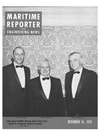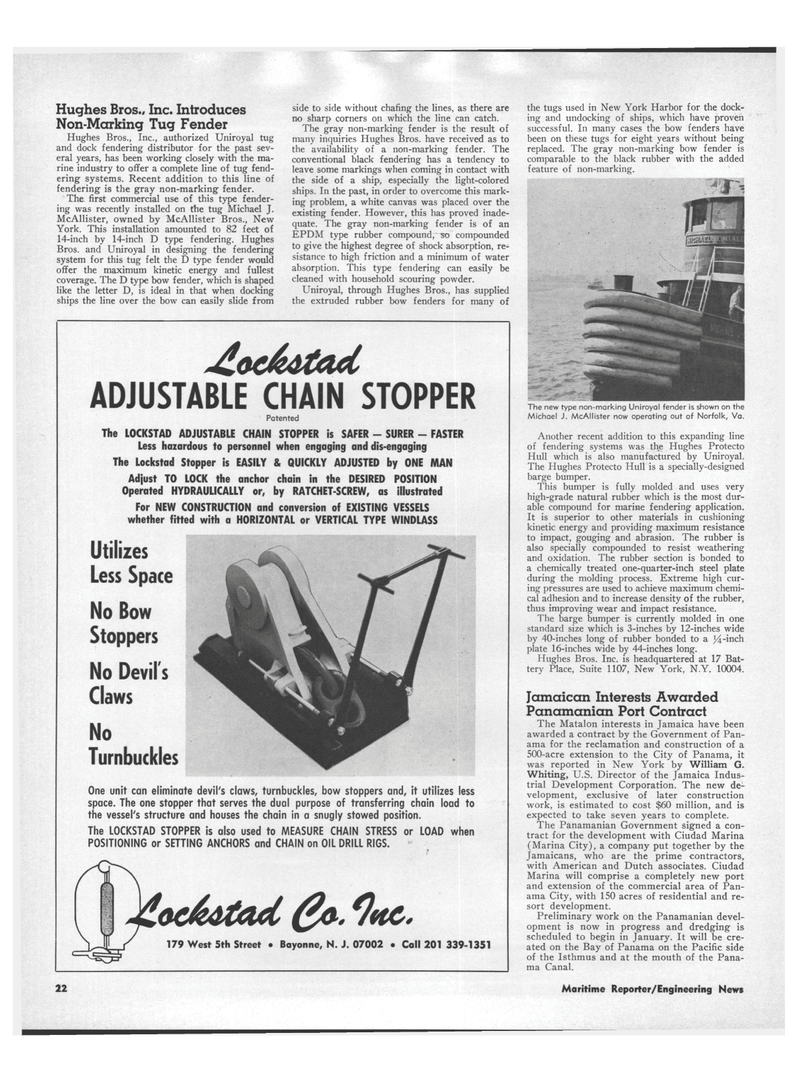
Page 20: of Maritime Reporter Magazine (December 15, 1970)
Read this page in Pdf, Flash or Html5 edition of December 15, 1970 Maritime Reporter Magazine
Hughes Bros., Inc. Introduces
Non-Marking Tug Fender
Hughes Bros., Inc., authorized Uniroyal tug and dock fendering distributor for the past sev- eral years, has been working closely with the ma- rine industry to offer a complete line of tug fend- ering systems. Recent addition to this line of fendering is the gray non-marking fender.
The first commercial use of this type fender- ing was recently installed on the tug Michael J.
McAllister, owned by McAllister Bros., New
York. This installation amounted to 82 feet of 14-inch by 14-inch D type fendering. Hughes
Bros, and Uniroyal in designing the fendering system for this tug felt the D type fender would offer the maximum kinetic energy and fullest coverage. The D type bow fender, which is shaped like the letter D, is ideal in that when docking ships the line over the bow can easily slide from side to side without chafing the lines, as there are no sharp corners on which the line can catch.
The gray non-marking fender is the result of many inquiries Hughes Bros, have received as to the availability of a non-marking fender. The conventional black fendering has a tendency to leave some markings when coming in contact with the side of a ship, especially the light-colored ships. In the past, in order to overcome this mark- ing problem, a white canvas was placed over the existing fender. However, this has proved inade- quate. The gray non-marking fender is of an
EPDM type rubber compound, so compounded to give the highest degree of shock absorption, re- sistance to high friction and a minimum of water absorption. This type fendering can easily be cleaned with household scouring powder.
Uniroyal, through Hughes Bros., has supplied the extruded rubber bow fenders for many of the tugs used in New York Harbor for the dock- ing and undocking of ships, which have proven successful. In many cases the bow fenders have been on these tugs for eight years without being replaced. The gray non-marking bow fender is comparable to the black rubber with the added feature of non-marking.
The new type non-marking Uniroyal fender is shown on the
Michael J. McAllister now operating out of Norfolk, Va.
Another recent addition to this expanding line of fendering systems was the Hughes Protecto
Hull which is also manufactured by Uniroyal.
The Hughes Protecto Hull is a specially-designed barge bumper.
This bumper is fully molded and uses very high-grade natural rubber which is the most dur- able compound for marine fendering application.
It is superior to other materials in cushioning kinetic energy and providing maximum resistance to impact, gouging and abrasion. The rubber is also specially compounded to resist weathering and oxidation. The rubber section is bonded to a chemically treated one-quarter-inch steel plate during the molding process. Extreme high cur- ing pressures are used to achieve maximum chemi- cal adhesion and to increase density of the rubber, thus improving wear and impact resistance.
The barge bumper is currently molded in one standard size which is 3-inches by 12-inches wide by 40-inches long of rubber bonded to a ^-inch plate 16-inches wide by 44-inches long.
Hughes Bros. Inc. is headquartered at 17 Bat- tery Place, Suite 1107, New York, N.Y. 10004.
Jamaican Interests Awarded
Panamanian Port Contract
The Matalon interests in Jamaica have been awarded a contract by the Government of Pan- ama for the reclamation and construction of a 500 -acre extension to the City of Panama, it was reported in New York by William G.
Whiting, U.S. Director of the Jamaica Indus- trial Development Corporation. The new de- velopment, exclusive of later construction work, is estimated to cost $60 million, and is expected to take seven years to complete.
The Panamanian Government signed a con- tract for the development with Ciudad Marina (Marina City), a company put together by the
Jamaicans, who are the prime contractors, with American and Dutch associates. Ciudad
Marina will comprise a completely new port and extension of the commercial area of Pan- ama City, with 150 acres of residential and re- sort development.
Preliminary work on the Panamanian devel- opment is now in progress and dredging is scheduled to begin in January. It will be cre- ated on the Bay of Panama on the Pacific side of the Isthmus and at the mouth of the Pana- ma Canal.
ADJUSTABLE CHAIN STOPPER
Patented
The L0CKSTAD ADJUSTABLE CHAIN STOPPER is SAFER - SURER - FASTER
Less hazardous to personnel when engaging and dis-engaging
The Lockstad Stopper is EASILY & QUICKLY ADJUSTED by ONE MAN
Adjust TO LOCK the anchor chain in the DESIRED POSITION
Operated HYDRAULICALLY or, by RATCHET-SCREW, as illustrated
For NEW CONSTRUCTION and conversion of EXISTING VESSELS whether fitted with a HORIZONTAL or VERTICAL TYPE WINDLASS
Utilizes
Less Space
No Bow
Stoppers
No Devil's
Claws
No
Turnbuckles
One unit can eliminate devil's claws, turnbuckles, bow stoppers and, it utilizes less space. The one stopper that serves the dual purpose of transferring chain load to the vessel's structure and houses the chain in a snugly stowed position.
The LOCKSTAD STOPPER is also used to MEASURE CHAIN STRESS or LOAD when
POSITIONING or SETTING ANCHORS and CHAIN on OIL DRILL RIGS.
}oc6afa

 19
19

 21
21
